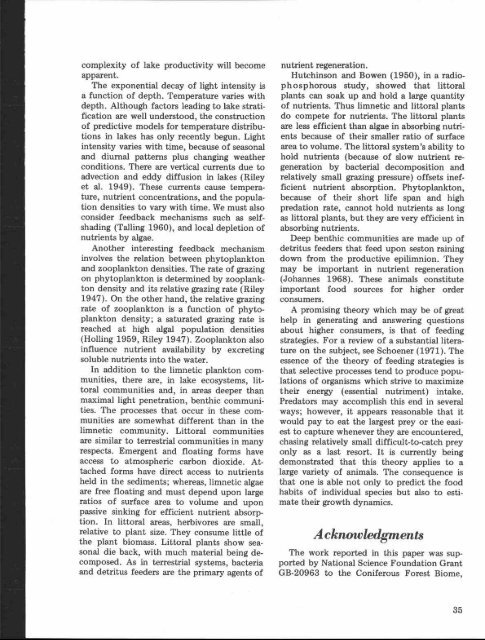PE EIE[R-Rg RESEARCH ON - HJ Andrews Experimental Forest
PE EIE[R-Rg RESEARCH ON - HJ Andrews Experimental Forest
PE EIE[R-Rg RESEARCH ON - HJ Andrews Experimental Forest
Create successful ePaper yourself
Turn your PDF publications into a flip-book with our unique Google optimized e-Paper software.
complexity of lake productivity will become<br />
apparent.<br />
The exponential decay of light intensity is<br />
a function of depth . Temperature varies with<br />
depth . Although factors leading to lake stratification<br />
are well understood, the construction<br />
of predictive models for temperature distributions<br />
in lakes has only recently begun . Light<br />
intensity varies with time, because of seasonal<br />
and diurnal patterns plus changing weathe r<br />
conditions . There are vertical currents due t o<br />
advection and eddy diffusion in lakes (Rile y<br />
et al . 1949) . These currents cause temperature,<br />
nutrient concentrations, and the population<br />
densities to vary with time . We must als o<br />
consider feedback mechanisms such as selfshading<br />
(Tailing 1960), and local depletion of<br />
nutrients by algae .<br />
Another interesting feedback mechanis m<br />
involves the relation between phytoplankto n<br />
and zooplankton densities . The rate of grazing<br />
on phytoplankton is determined by zooplankton<br />
density and its relative grazing rate (Riley<br />
1947) . On the other hand, the relative grazing<br />
rate of zooplankton is a function of phytoplankton<br />
density ; a saturated grazing rate is<br />
reached at high algal population densities<br />
(Holling 1959, Riley 1947) . Zooplankton also<br />
influence nutrient availability by excretin g<br />
soluble nutrients into the water .<br />
In addition to the limnetic plankton communities,<br />
there are, in lake ecosystems, littoral<br />
communities and, in areas deeper tha n<br />
maximal light penetration, benthic communities.<br />
The processes that occur in these communities<br />
are somewhat different than in th e<br />
limnetic community . Littoral communities<br />
are similar to terrestrial communities in many<br />
respects . Emergent and floating forms have<br />
access to atmospheric carbon dioxide . Attached<br />
forms have direct access to nutrients<br />
held in the sediments ; whereas, limnetic algae<br />
are free floating and must depend upon larg e<br />
ratios of surface area to volume and upo n<br />
passive sinking for efficient nutrient absorption.<br />
In littoral areas, herbivores are small ,<br />
relative to plant size . They consume little of<br />
the plant biomass. Littoral plants show seasonal<br />
die back, with much material being de -<br />
composed . As in terrestrial systems, bacteri a<br />
and detritus feeders are the primary agents of<br />
nutrient regeneration .<br />
Hutchinson and Bowen (1950), in a radiophosphorous<br />
study, showed that littoral<br />
plants can soak up and hold a large quantity<br />
of nutrients . Thus limnetic and littoral plant s<br />
do compete for nutrients . The littoral plants<br />
are less efficient than algae in absorbing nutrients<br />
because of their smaller ratio of surfac e<br />
area to volume . The littoral system's ability to<br />
hold nutrients (because of slow nutrient re -<br />
generation by bacterial decomposition an d<br />
relatively small grazing pressure) offsets inefficient<br />
nutrient absorption. Phytoplankton ,<br />
because of their short life span and hig h<br />
predation rate, cannot hold nutrients as long<br />
as littoral plants, but they are very efficient in<br />
absorbing nutrients .<br />
Deep benthic communities are made up o f<br />
detritus feeders that feed upon seston rainin g<br />
down from the productive epilimnion . They<br />
may be important in nutrient regeneration<br />
(Johannes 1968) . These animals constitute<br />
important food sources for higher orde r<br />
consumers .<br />
A promising theory which may be of great<br />
help in generating and answering question s<br />
about higher consumers, is that of feeding<br />
strategies. For a review of a substantial literature<br />
on the subject, see Schoener (1971) . The<br />
essence of the theory of feeding strategies i s<br />
that selective processes tend to produce populations<br />
of organisms which strive to maximiz e<br />
their energy (essential nutriment) intake .<br />
Predators may accomplish this end in severa l<br />
ways; however, it appears reasonable that i t<br />
would pay to eat the largest prey or the easiest<br />
to capture whenever they are encountered ,<br />
chasing relatively small difficult-to-catch prey<br />
only as a last resort . It is currently being<br />
demonstrated that this theory applies to a<br />
large variety of animals. The consequence is<br />
that one is able not only to predict the foo d<br />
habits of individual species but also to estimate<br />
their growth dynamics .<br />
Acknowledgments<br />
The work reported in this paper was supported<br />
by National Science Foundation Grant<br />
GB-20963 to the Coniferous <strong>Forest</strong> Biome ,<br />
35








